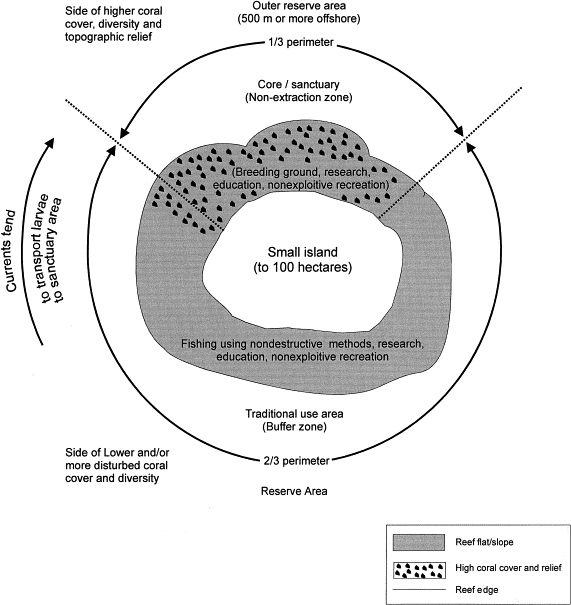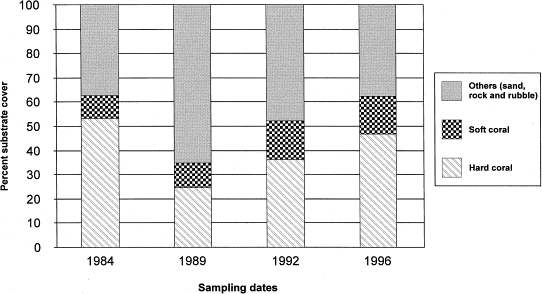CommunityManagement: Difference between revisions
From coraldigest
No edit summary |
|||
| Line 4: | Line 4: | ||
*Information here | *Information here | ||
'''Characteristics of successful community-based management: | '''Characteristics of successful community-based management: <ref> http://www.worldfishcenter.org/resource_centre/LessonsLearned1804%20-%20FINAL.pdf </ref> | ||
''' | ''' | ||
*Creating a coral reef management plan with community input that includes not only ecological conditions but also socioeconomic concerns (environmental regeneration and preservation of the reefs and livelihood enhancement for communities) -> should not trade off environmental preservation for poverty | *Creating a coral reef management plan with community input that includes not only ecological conditions but also socioeconomic concerns (environmental regeneration and preservation of the reefs and livelihood enhancement for communities) -> should not trade off environmental preservation for poverty | ||
| Line 22: | Line 22: | ||
'''Case Studies of successful community-based management: | '''Case Studies of successful community-based management: | ||
''' | ''' | ||
*Indonesia: Community-based coral reef management | *Indonesia: Community-based coral reef management<ref>http://web.worldbank.org/WBSITE/EXTERNAL/TOPICS/EXTARD/EXTAGISOU/0,,contentMDK:20951530~menuPK:2758410~pagePK:64168445~piPK:64168309~theSitePK:2502781,00.html</ref> | ||
**Coral Reef Rehabilitation and Management Program I | **Coral Reef Rehabilitation and Management Program I | ||
***Compliance increased by 10% after the implementation of the management project | ***Compliance increased by 10% after the implementation of the management project | ||
| Line 30: | Line 30: | ||
***There should be communication and agreement between national/state/local governments as well as coastal communities. | ***There should be communication and agreement between national/state/local governments as well as coastal communities. | ||
*Community-based coral reef management on san Salvador island, the Philippines | *Community-based coral reef management on san Salvador island, the Philippines <ref> http://www.tandfonline.com/doi/abs/10.1080/08941929409380849 </ref> | ||
**MCPSS (1988) | **MCPSS (1988) | ||
***Through community education, organization and participatory decision making developed municipal marine park, non-fishing sanctuary, and fishing reserves surrounding the island reduced destructive fishing methods leading to a decline fish population (blasting, fine mesh nets and sodium cyanide) | ***Through community education, organization and participatory decision making developed municipal marine park, non-fishing sanctuary, and fishing reserves surrounding the island reduced destructive fishing methods leading to a decline fish population (blasting, fine mesh nets and sodium cyanide) | ||
| Line 38: | Line 38: | ||
****Establishing a municipal marine reserve and sanctuary stopped coral reef destruction | ****Establishing a municipal marine reserve and sanctuary stopped coral reef destruction | ||
*Community-based reef conservation in the Philippines | *Community-based reef conservation in the Philippines <ref> http://www.sciencedirect.com/science/article/pii/S0025326X9900243X </ref> | ||
**Provinces of Negros Oriental, Batangas and the Tubbataha Reef National Marine Park, Palawan | **Provinces of Negros Oriental, Batangas and the Tubbataha Reef National Marine Park, Palawan | ||
[[File:Marine reserve.gif|Figure 1: Example of a marine reserve system, displaying the demarcation between the traditional use area (fishing allowed) and the reserve area (usually areas with more disturbed coral cover, so are treated more as protected areas).]] | [[File:Marine reserve.gif|frame|Figure 1: Example of a marine reserve system, displaying the demarcation between the traditional use area (fishing allowed) and the reserve area (usually areas with more disturbed coral cover, so are treated more as protected areas).]] | ||
*In Negros and Batangas, coastal communities and fishermen are included in the decision-making process. These communities fish using nondestructive methods (allowing reef fish to regenerate sustainably) and the reefs are divided into zones so that fishing does not happen in breeding grounds. | *In Negros and Batangas, coastal communities and fishermen are included in the decision-making process. These communities fish using nondestructive methods (allowing reef fish to regenerate sustainably) and the reefs are divided into zones so that fishing does not happen in breeding grounds. | ||
**Coral reef cover (for hard and soft corals) has been increasing since this policy was put into place. | **Coral reef cover (for hard and soft corals) has been increasing since this policy was put into place. | ||
[[File:Substrate change.gif|Figure 2: Graph displays steady increases in soft and hard coral cover over past two decades.]] | [[File:Substrate change.gif|frame|Figure 2: Graph displays steady increases in soft and hard coral cover over past two decades.]] | ||
'''Conclusion''' | '''Conclusion''' | ||
== Notes == | |||
<references /> | |||
http://web.worldbank.org/WBSITE/EXTERNAL/TOPICS/EXTARD/EXTAGISOU/0,,contentMDK:20951530~menuPK:2758410~pagePK:64168445~piPK:64168309~theSitePK:2502781,00.html | |||
http://www.tandfonline.com/doi/abs/10.1080/08941929409380849 | |||
http://www.sciencedirect.com/science/article/pii/S0025326X9900243X | |||
http://www.worldfishcenter.org/resource_centre/LessonsLearned1804%20-%20FINAL.pdf | |||
Revision as of 13:10, 25 February 2013
Community-based Reef Management
Introduction:
- Information here
Characteristics of successful community-based management: [1]
- Creating a coral reef management plan with community input that includes not only ecological conditions but also socioeconomic concerns (environmental regeneration and preservation of the reefs and livelihood enhancement for communities) -> should not trade off environmental preservation for poverty
- The planning process should be transparent and fair
- Successful communication between administrative/government officials and stakeholders in the community
- Clear and concise rules of access, withdrawal, exclusion etc.
- Rules must be made with community involvement and support
- For example: issuing a limited number of fishing permits, creating user organizations so as to monitor any illegal withdrawal of reef fish etc.
- Rules must be made with community involvement and support
- Clear and concise rules of access, withdrawal, exclusion etc.
- Capacity building within the community, including education and empowerment so that community members are both made cognizant of the importance of coral reefs in global biodiversity and take ownership of them.
- Public awareness campaigns
- Institutional buy-ins
- Effective monitoring of coral reefs
- Effective enforcement of rules of access/withdrawal/exclusion etc.
- Communication between stakeholders & venues for resolving any conflicts
- Allow for iterative feedback loops so that government, interested NGOs, and community members can learn from past mistakes and work together for more sustainable future.
Case Studies of successful community-based management:
- Indonesia: Community-based coral reef management[2]
- Coral Reef Rehabilitation and Management Program I
- Compliance increased by 10% after the implementation of the management project
- Illegal and over fishing as well as coral mining in pilot locations decreased 50% after the management project was constructed
- Lessons learned from Indonesia’s experiment with community-based coral reef management:
- Communities must be central to the planning, implementation, and post-project portions.
- There should be communication and agreement between national/state/local governments as well as coastal communities.
- Coral Reef Rehabilitation and Management Program I
- Community-based coral reef management on san Salvador island, the Philippines [3]
- MCPSS (1988)
- Through community education, organization and participatory decision making developed municipal marine park, non-fishing sanctuary, and fishing reserves surrounding the island reduced destructive fishing methods leading to a decline fish population (blasting, fine mesh nets and sodium cyanide)
- Affect societal change through mass organizations or unions
- education, capacity building, and implementing concrete community projects, train community leaders with the knowledge and skills for sustainable resource management, and establish a network system
- Three islands: Apo, Pamilacan, and Balicasag
- Establishing a municipal marine reserve and sanctuary stopped coral reef destruction
- MCPSS (1988)
- Community-based reef conservation in the Philippines [4]
- Provinces of Negros Oriental, Batangas and the Tubbataha Reef National Marine Park, Palawan

- In Negros and Batangas, coastal communities and fishermen are included in the decision-making process. These communities fish using nondestructive methods (allowing reef fish to regenerate sustainably) and the reefs are divided into zones so that fishing does not happen in breeding grounds.
- Coral reef cover (for hard and soft corals) has been increasing since this policy was put into place.

Conclusion
Notes
- ↑ http://www.worldfishcenter.org/resource_centre/LessonsLearned1804%20-%20FINAL.pdf
- ↑ http://web.worldbank.org/WBSITE/EXTERNAL/TOPICS/EXTARD/EXTAGISOU/0,,contentMDK:20951530~menuPK:2758410~pagePK:64168445~piPK:64168309~theSitePK:2502781,00.html
- ↑ http://www.tandfonline.com/doi/abs/10.1080/08941929409380849
- ↑ http://www.sciencedirect.com/science/article/pii/S0025326X9900243X
http://web.worldbank.org/WBSITE/EXTERNAL/TOPICS/EXTARD/EXTAGISOU/0,,contentMDK:20951530~menuPK:2758410~pagePK:64168445~piPK:64168309~theSitePK:2502781,00.html http://www.tandfonline.com/doi/abs/10.1080/08941929409380849 http://www.sciencedirect.com/science/article/pii/S0025326X9900243X http://www.worldfishcenter.org/resource_centre/LessonsLearned1804%20-%20FINAL.pdf